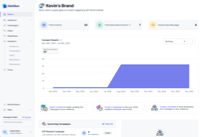
The new SlickText API is now available.
For accounts created prior to January 22, 2025, visit the legacy API.
Overview
Here is an overview of what you need to know to begin working with the SlickText API. As always, if you have questions, feel free to contact us.
Base URL
The base URL for all SlickText API calls is:
SlickText API calls within a brand will require a Brand ID to be included in the URL. This is the ID of the brand you are working with. The Brand ID can be found using the retrieve brand information endpoint. For example, to retrieve all contacts for a brand with an ID of 1234567890, the URL would be:
Versioning
We currently have 2 versions of our API. If your account is with our legacy system, the API documentation lives here.
To determine if you have a legacy account:
- Log into your account.
- If the URL is “https://www.slicktext.com/dashboard/” then you have a legacy account.
We do our best to make sure any changes or additions won't break applications you’re currently using. If this is a possibility, we'll release a new version, and you can continue using V1.
Authorization
In order to authenticate, you'll need the API keys from your SlickText account. If you haven't used them before, they may need to be generated. Click the ellipsis beside your name on the bottom left of your dashboard. Select the Settings menu item. Once on the Settings page, select API & Webhooks and then select API Keys. Finally, click Create API Key to get your key.

The key should be in the request Authorization header, used as a Bearer token.
Content Type
The Content-Type header for the request should be set to application/json, and the request body should be formatted as JSON.
Rate Limiting
By default, requests to our API are limited to 8 per second or 480 per minute. This is measured over a 60-second window to allow for short bursts. All responses to authenticated requests will include three specific headers that give you the current status of your limit.
| HEADER NAME | DESCRIPTION |
|---|---|
| x-RateLimit | The maximum number of requests you can make per window |
| x-RateLimit-Remaining | The number of requests remaining in the current rate limit window. |
| x-RateLimit-Reset | The number of seconds until the current rate limit window resets |
These limits can be adjusted. If your account/use case requires additional throughput, please reach out to our support team to discuss increasing your rate limits.
The Response
A successful response will result in an HTTP status code of 200, and the response body will be a JSON string representing the results.
Example Successful Response:
{
"brand_id": 1234567890,
"name": "SlickText",
"website": "http://www.slicktext.com",
"industry": "retailEcommerce",
"prohibited_content": "0",
"use_case": "mixed",
"address": "301 E 2nd St #304",
"city": "Jamestown",
"state": "NY",
"zip": "14701",
"country": "US",
"contact_first_name": "Johnny",
"contact_last_name": "SlickText",
"contact_email": "johnny@slicktext.com",
"contact_phone": "+17165551212",
"_account_id": "987654321",
"created": "2024-01-17 20:25:52",
"last_updated": "2024-01-17 20:25:53"
}
A failure will result in a non-200 status code. The response body, in this case, will contain a message that will hopefully give you some insight into what happened.
| ERROR CODE | ERROR REASON |
|---|---|
| 400 | Bad Request - There was an error in your request |
| 403 | Forbidden - Your account doesn’t have access to that resource |
| 404 | Not Found - That resource doesn’t exist |
| 500 | Internal Server Error - Oops. We did something wrong (hopefully just a typo) |
Example responses will be included in the documentation for our specific resources.
Pagination
To manage large sets of data, our API uses pagination. By default, the first set of 50 items will be returned. You can control the number of items returned in a single response with the limit parameter, which has a maximum value of 250. Use the offset parameter to skip a specified number of items.
For example, the request below would return 10 items starting with the 21st item.
You can pass a page and pageSize parameter to get a specific page of results. The pageSize parameter is the number of items per page, and the page parameter is the page number. The page parameter starts at 0. This means the first page would be returned when specifying pageSize=0.
For example, the request below would return the 4th page of results with 10 items per page.
Query Parameters
When retrieving multiple items, you may want to include additional criteria in the query string to filter the results by. Any field that is included in the resource response is available for use as a filter. These are exact matches; they are case-sensitive and do not allow wildcards.
For example, the request below would return all contacts with the first name of "Johnny".